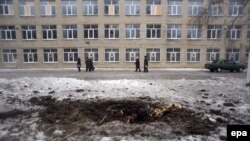Speaking to reporters alongside his Hungarian counterpart, Russian President Vladimir Putin placed blame for the recent surge in fighting in the Donbass region of Ukraine on the Ukrainian government.
In his February 2 remarks, Putin said the spike in violence “was provoked by the Ukrainian side.”
Ukraine has been involved in a military conflict since April 2014 in the Donbass region against two secessionist movements, the Donetsk and Lugansk People’s Republics. They are widely regarded as being directly controlled and armed by Russia and Russian military forces.
Russia denies support for the separatists or involvement in the conflict, saying separatists are made up of local and Russian “volunteers.” But fighting on the ground shows clear Russian involvement.
An agreement signed in February 2015, known as the Minsk II Protocols, was supposed to halt the fighting and chart a path towards political resolution. However, implementation has been highly contested.
While Putin claims that “actual fighting began” on January 27, some combat throughout the Line of Contact has been on-going since 2015.
Violations of the ceasefire have been routine for almost two years. Fighting in recent weeks is among the most intense that OSCE monitors have recorded in Ukraine.
Russia has pushed a narrative that Ukraine is responsible for igniting the surge in violence.
Putin’s press secretary, Dmitry Peskov, referred to a “creeping offensive” by Ukrainian forces. Putin adviser Yuri Ushakov claimed that Ukraine “began attacks, began artillery bombardments, to which the volunteers were forced to respond.”
Ukraine has been recently conducting military maneuvers in Donbass which included advances against pro-Russian positions, as reported by RFE/RL's Christopher Miller.
However, Russian officials failed to note that the Ukrainian maneuvers took place within a so-called “gray zone” in Donbass.
That is territory on the Ukrainian side of the “Line of Contact” designated by the Minsk II accord, which is occupied by Russian-backed forces in defiance of a ceasefire.
According to the Ukrainian governor of Donetsk Oblast, Pavlo Zhebrivskyy, Ukrainian forces moved into the “gray zone” to halt the smuggling of pork products into separatist territories through a nearby swine farm.
Franklin Holcomb, who monitors the Donbass conflict for the Institute for the Study of War, told Polygraph.info: “if this escalation was about the creeping offensive, and the separatist forces were resisting those encroachments, the fighting would actually be happening in those grey zones. It isn’t.”
Ukrainian maneuvers have been focused upon sparsely-populated areas, Holcomb said.
But pro-Russian bombardments and assaults have been focused on the front line town of Avdiivka.
“It makes no sense that Ukrainian forces would be carrying out an offensive in the area around Avdiivka,” Holcomb said, explaining that Ukrainian attacks against the heavy pro-Russian fortifications in the area would be useless.
“This sort of escalation could not have been in response to the minor maneuvers of Ukrainian forces in the gray zone,” he said.
The fighting around Avdiivka represents “a deliberate decision by separatist and/or Russian military commanders to respond in such a massively escalatory fashion,” Holcomb said.
According to Holcomb, the heavy Russian military response was entirely out of proportion to the 200-meter incursion into pro-Russian territory by the Ukrainians alleged by Putin.
There is no end in sight to the nearly three-year conflagration that has taken at least 9,750 lives since April 2014 and soured relations between Russia and the West.
At least 35 civilians and fighters on both sides have been killed and many dozens more wounded since January.
Some news reports see the escalation in violence as closely connected to U.S. President Donald Trump’s phone call with Vladimir Putin, which took place the day before the surge in fighting in late January.
Kostiatyn Yeliseieiv, deputy head of the Ukrainian presidential administration, told the Guardian that Russian escalation is “a test from the Russian side of the reaction of the new American administration and unity inside the European Union.”
The OSCE Special Monitoring Mission for Ukraine has repeatedly urged both sides to withdraw their heavy weapons and cease firing.
First-hand Reports from the fighting tell how both sides engaged in combat and employed heavy military equipment like tanks and artillery in violation of Minsk II. Both sides have located military equipment in civilian-occupied residential areas, which arguably violates the laws of war.
Aric Toler, an analyst with Bellingcat who has also worked with the Atlantic Council’s Digital Forensics Research Lab, told Polygraph.info that while it is impossible to tell which side fired the first shots, both Ukrainian and pro-Russian forces are directly complicit in the surge in violence recently in Donbass.




